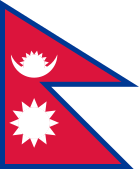Flag of Nepal
 |
|
| Use | National flag |
|---|---|
| Proportion | see below |
| Adopted | December 16, 1962 |
| Design | Combination of two red pennons with a blue border, with a sun and crescent moon |

Variant flag of Nepal
|
|
| Use | Old flag of Nepal before 1962 |
The national flag of Nepal (Nepali: नेपालको झण्डा) is the world's only non-quadrilateral national flag. The flag is a simplified combination of two single pennons, the vexillological word for a pennant. Its crimson red is the colour of the rhododendron, the country's national flower. The blue border is the colour of peace. Until 1962, the flag's emblems, the sun and the crescent moon, had human faces. They were removed to modernize the flag.
The flag was adopted, with the formation of a new constitutional government, on December 16, 1962. The individual pennants had been used for the preceding two centuries and the double pennant since the 19th century. The flag borrows the basic design from the original design, which has been in use for more than 2,000 years.
The flag was adopted after Prithvi Narayan Shah unified all small principalities of Nepal. In modern times the concept of the flag has changed to have a different meaning. The blue border symbolizes peace and harmony. The crimson red is Nepal's national color, and it indicates the brave spirits of the Nepalese people. The two triangles symbolize the Himalaya Mountains. The depiction of celestial bodies represents permanence, the hope that Nepal will last as long as the sun and the moon.
The moon symbolizes that the Nepalese are soothing and calm, while the sun symbolizes fierce resolve. The moon also symbolizes the shades and the cool weather of the Himalayas, whereas the sun symbolizes the heat and the high temperature at the lower part (Tarai) of Nepal. Another interpretation: The flag's shape could also symbolize a Nepalese pagoda – as noted by local Nepalese, placing a mirror at the hoist side will generate an image of a pagoda.
There is a precise description of the Nepalese national flag in the Constitution of the Kingdom of Nepal, Article 5, Schedule 1, adopted 9 November 1990.
(A) Method of Making the Shape inside the Border
(B) Method of Making the Moon
(C) Method of making the Sun
...
Wikipedia
